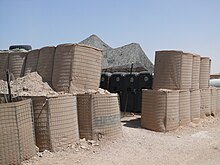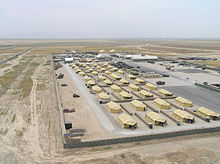| Revision as of 17:20, 27 August 2012 editTeratornis (talk | contribs)Extended confirmed users, Pending changes reviewers, Rollbackers14,819 edits 'Concertainer' is a portmanteau of 'concertina' and 'container'; add citation to support this statement← Previous edit | Revision as of 17:14, 28 August 2012 edit undoTeratornis (talk | contribs)Extended confirmed users, Pending changes reviewers, Rollbackers14,819 editsm remove link on container per the advice of User:DPL bot, since disambiguation pages are not considered desirable link targetsNext edit → | ||
| Line 8: | Line 8: | ||
| Originally designed for use on beaches and marshes for ] and flood control,<ref>'''' - ], Engineer Research and Development Center, Factsheet January 2006</ref> the HESCO Bastion quickly became a popular security device in the 1990s.<ref>'''' - The Talon, ], Friday 6 December 1996</ref> Hesco barriers continue to be used for their original purpose. They were used in 2005 to reinforce ] around New Orleans in the few days between Hurricanes ] and ].<ref>'''' - ''Progressive Engineer'', 2006</ref> During the ] 27,000 feet of Hesco barrier wall were shipped to Iowa.<ref>'''' - David, David; ''Hammond Daily Star'', June 25, 2008</ref> In late March, 2009, 35,000 feet of Hesco barrier were delivered to ] to fight floods. | Originally designed for use on beaches and marshes for ] and flood control,<ref>'''' - ], Engineer Research and Development Center, Factsheet January 2006</ref> the HESCO Bastion quickly became a popular security device in the 1990s.<ref>'''' - The Talon, ], Friday 6 December 1996</ref> Hesco barriers continue to be used for their original purpose. They were used in 2005 to reinforce ] around New Orleans in the few days between Hurricanes ] and ].<ref>'''' - ''Progressive Engineer'', 2006</ref> During the ] 27,000 feet of Hesco barrier wall were shipped to Iowa.<ref>'''' - David, David; ''Hammond Daily Star'', June 25, 2008</ref> In late March, 2009, 35,000 feet of Hesco barrier were delivered to ] to fight floods. | ||
| Specifically, the brand name for the barrier is 'Concertainer' (a ] of ']' and ' |
Specifically, the brand name for the barrier is 'Concertainer' (a ] of ']' and 'container'<ref name="Heselden97">{{cite conference | ||
| | url = http://books.google.com/books?id=yYFKGHm4yLYC&pg=PA129&source=gbs_toc_r&cad=4#v=onepage&q&f=false | | url = http://books.google.com/books?id=yYFKGHm4yLYC&pg=PA129&source=gbs_toc_r&cad=4#v=onepage&q&f=false | ||
| | title = Reinforcement and Control Using Concertainers | | title = Reinforcement and Control Using Concertainers | ||
Revision as of 17:14, 28 August 2012




The HESCO bastion is both a modern gabion used for flood control and military fortification and the name of the British company that developed it in the late 1980s. It is made of a collapsible wire mesh container and heavy duty fabric liner, and used as a temporary to semi-permanent dike or barrier against blasts or small-arms. It has seen considerable use in Iraq and Afghanistan.
Originally designed for use on beaches and marshes for erosion and flood control, the HESCO Bastion quickly became a popular security device in the 1990s. Hesco barriers continue to be used for their original purpose. They were used in 2005 to reinforce levees around New Orleans in the few days between Hurricanes Katrina and Rita. During the June 2008 Midwest floods 27,000 feet of Hesco barrier wall were shipped to Iowa. In late March, 2009, 35,000 feet of Hesco barrier were delivered to Fargo, North Dakota to fight floods.
Specifically, the brand name for the barrier is 'Concertainer' (a portmanteau of 'concertina' and 'container'), with 'HESCO Bastion' being the British company that produces it, though the barrier itself is quite generally referred to as a HESCO Bastion, or simply "Hesco".
Development
The HESCO bastion was originally developed by a British entrepreneur and ex-coal miner named Jimi Heselden, who in 1989 founded Hesco Bastion Ltd. to manufacture his invention.
Assembly
Assembling the HESCO bastion entails unfolding it and filling it with sand, dirt or gravel - usually using a front end loader. The placement of the barrier is generally very similar to the placement of a sandbag barrier or earth berm except that room must generally be allowed for the equipment used to fill the barrier. The main advantage of HESCO barriers, strongly contributing to their popularity with troops and flood fighters, is the quick and easy setup. Previously, people had to fill sandbags, a slow undertaking, with one worker filling about 20 sandbags per hour. Workers using HESCO barriers and a front end loader can do ten times the work of those using sandbags.
The HESCO barriers come in a variety of sizes. Most of the barriers can also be stacked, and they are shipped collapsed in compact sets. Example dimensions of typical configurations are 1.4m x 1.1m x 9.8m (4’6” x 3’6” x 32’) to 2.1m x 1.5m x 30m (7’ x 5’ x 100’).
A new system of HESCO Bastion concertainer developed specially for military use is deployed from a container, which is dragged along the line of ground where the barrier is to be formed, unfolding up to several hundred meters of barrier ready for filling within minutes.
Protection
| This section does not cite any sources. Please help improve this section by adding citations to reliable sources. Unsourced material may be challenged and removed. (July 2012) (Learn how and when to remove this message) |
Filled with sand, 60 centimetres (24 inches) of barrier thickness will stop rifle bullets, shell fragments and other shrapnel. Approximately 1.2 metres (four feet) of thickness provides protection against most car bombs. It takes 1.5 metres (five feet) of thickness to prevent penetration by a rocket-propelled grenade round. In addition, HESCO bastions are even more effective than sandbags against water.
See also
- Bremer wall, steel-reinforced concrete blast walls
- Gabion, a historic precursor for both erosion control and defense
- Sandbag, the low-tech precursor / alternative
References
- Flood Fighting Structures Demonstration and Evaluation Program - US Army Corps of Engineers, Engineer Research and Development Center, Factsheet January 2006
- Engineers wall Dobol - The Talon, Operation Joint Endeavour, Friday 6 December 1996
- HESCO Bastion - A simple approach to flood protection and much more - Progressive Engineer, 2006
- Hammond company helps Midwest hold back flood - David, David; Hammond Daily Star, June 25, 2008
- Heselden, J.W. (1997). "Reinforcement and Control Using Concertainers". In C.V.J. Varma (ed.). Geosynthetics Asia 1997: Select papers. Geosynthetics Asia 1997. G. Venkatappa Rao; A.R.G. Rao. Bangalore, India: CRC Press. p. 496. ISBN 9789054107705. Retrieved 2012-08-27.
The name "Concertainer", which is a registered trade mark, refers to the unique way that units fold flat concertina style. This ensures very efficient packaging, handling, and erection.
{{cite conference}}: External link in|conferenceurl=|booktitle=ignored (|book-title=suggested) (help); Unknown parameter|conferenceurl=ignored (|conference-url=suggested) (help); Unknown parameter|month=ignored (help) - Ex-miner's £10m gift to good causes - Yorkshire Post/Yorkshire Evening Post, March 20, 2008.
- "Owner of Segway Company Dies in Segway Accident" New York Times, Sept. 27, 2010
- Mike Nowatzki, Flood Update: Portable floodwalls will be used in flood fight as city scrambles for protection The Fargo-Moorhead INFORUM March 23, 2009.
- HESCO RAID (from the manufacturer website)
External links
- Hesco Bastion Ltd (homepage of the 'Hesco' manufacturer)
- Hesco FaceBook page